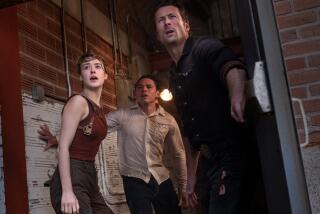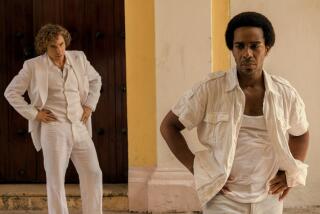History’s on the Ropes in ‘Hurricane’
Most Americans understand that “real life” movies rise or fall on their entertainment value and accept that at least some elements of fiction are mixed together with fact. However, Universal Pictures’ “The Hurricane” crosses the line between reasonable embellishment and pernicious distortion.
Though moviegoers do learn that a middleweight boxing contender, Rubin “Hurricane” Carter, was imprisoned for 20 years on trumped-up murder charges, the film transforms his painful story into a series of false cliches: He was jailed because of one racist cop; he was freed through the efforts of a commune of white people. In reality, Carter was ensnared by an entire criminal justice system.
Along with Myron Beldock and Leon Friedman, I spent more than a decade representing Rubin Carter and his co-defendant, John Artis, fighting to expose police-created false evidence, prosecutorial misconduct and judicial acceptance of a trial by race rather than fact. During years of appeals through the New Jersey state court system in the late 1970s and ‘80s, not one of the more than 20 state court judges who reviewed the case was willing to confront the racism behind the unproven accusation that Carter and Artis murdered three randomly chosen whites to avenge an earlier killing of a black man by a white man. Nor were the state court judges willing to expose the police for Lewis M. Steel is a civil rights attorney practicing in New York City. He was part of the Carter-Artis defense team from 1975 to 1988. Steel was the lead attorney for John Artis.
In short, what the movie public could have learned from this case was that the Southern-style justice of an earlier era could still occur anywhere in the United States.
Ironically, the true story contained enough drama to satisfy any moviegoer. On a summer night in 1966 in Paterson, N.J., two black men burst into a bar, and for reasons that still remain unclear, shot and killed three white people and wounded another. Originally, the police had reason to focus on Carter and Artis. A witness said two black men fled the scene in a white car with out-of-state license plates. Carter and John Artis, who had never been in trouble with the law and was about to go to college on an athletic scholarship, were picked up in the vicinity shortly after the crime in a white car with out-of-state plates. Beyond that, however, all the evidence pointed against guilt.
A third man had been in the car. Two survivors of the barroom murders gave descriptions of the killer that did not fit Carter and Artis, nor did anyone identify them after the killings. In custody, Carter and Artis talked to the police freely without asking for lawyers, accounted for where they had been and agreed to take lie-detector tests, which they passed. As a result, the chief police investigator told a grand jury that Carter and Artis could not be the killers.
A few months later the police, having found no murder weapons, fingerprints or other evidence and not even discerning a motive, were desperate to solve this very public crime. To do so, they pressured two petty criminals who were committing a burglary down the street from the bar where the murders occurred to identify Carter and Artis. To bolster their case, the police planted a bullet and a shotgun shell in Carter’s car and coached a key witness into identifying that car as the getaway vehicle.
In 1967, an all-white jury, during a time of great tension fueled by racial rebellions in Newark and other urban cities, convicted the two men. But the New Jersey Supreme Court threw out the verdict in 1976 because the prosecutors had failed to reveal that they had given the two petty thieves deals in return for their testimony.
Rather than accepting that the police had coerced witnesses and perjured themselves and that the remaining evidence pointed to Carter and Artis’ innocence, the prosecutors decided to retry them. At this second trial, in front of a predominantly white jury, only one of the petty thieves testified, telling a ridiculous jumble of conflicting stories. In addition, our defense team showed that the planted bullet and shell did not match the ammunition used in the killings and that the automobile identification was an inaccurate invention of the police.
Concocting a Theory
To make up for their lack of evidence, the prosecutors, two of whom were rewarded with state court judgeships, concocted their malignant racial-revenge theory. It worked. The jury wasted no time rendering guilty verdicts, and the trial judge reimposed life sentences. Later, when an alternate juror came forward to testify about jury room racism, and a former county investigator as well as a former assistant prosecutor testified that the prosecutors shamelessly falsified and manipulated evidence, the same trial judge ruled they were mentally unbalanced.
Unfortunately, the movie leaves out virtually everything that happened. Instead, it falsely pictures a group of white Canadians finding key evidence and surviving a threat on their lives by the one racist cop. The Canadians and an African American boy they were raising did give Carter psychological support during his darkest hours, and provided our defense-team attorneys with excellent paralegal support, but they uncovered none of the evidence that led to the overturning of Carter and Artis’ convictions.
Only thousands of hours of our defense team’s work and the intervention of U.S. District Judge H. Lee Sarokin in 1985, who invoked the federal writ of habeas corpus to nullify these unconstitutional convictions, unraveled the prosecution case and brought daylight into this nightmare.
Because the movie sugarcoats the story, the audience not only sympathizes with Carter’s struggle for freedom (Artis is barely seen), and feels good when Judge Sarokin releases him, but also leaves with the thought that our criminal justice system eventually works. Accurate or not, isn’t that enough for one movie to accomplish? The answer is no. By depriving the audience of the opportunity to see just how racist the criminal justice system can be, and to what extent prosecutors will go to obtain unjust convictions, the audience did not learn why so many blacks feel they do not get a fair chance.
If “The Hurricane” had shown what happened, many more people might have come to understand why the predominantly black jury in the O.J. Simpson case was so quick to acquit him and why so many black Americans applauded that decision.
But a final nagging question remains. Must art be socially useful in order to be worthwhile? After all, socially useful art sounds suspiciously like state-controlled art. Put that way, the answer must be no. And with Denzel Washington playing Carter, director Norman Jewison certainly has created a strong movie that does convey the enormity of the injustice that occurred. But that is not the whole answer.
Here, we are not talking about what audiences may like, but what is honest and true. Where a story is little known, as this one was, Hollywood must realize that the public will learn almost everything it knows about the event from the movie. Unlike the Oliver Stone film “JFK,” for example, where almost everyone comes into the movie having their own take on how the former president was killed, and where the truth about the event was buried with his killer, a judgment about how Rubin Carter and John Artis were convicted has been rendered based upon irrefutable facts.
To discard and distort these facts does us all a real disservice. Taking the easy way out of a complex story by creating a soap opera instead of engaging in the hard work of crafting a real story cheats the public out of a much more meaningful movie experience.
More to Read
Only good movies
Get the Indie Focus newsletter, Mark Olsen's weekly guide to the world of cinema.
You may occasionally receive promotional content from the Los Angeles Times.










